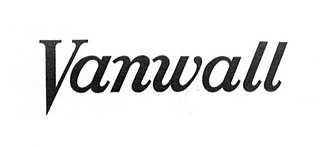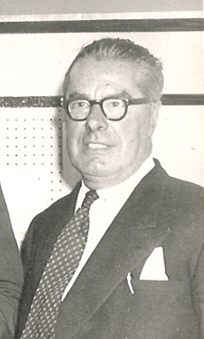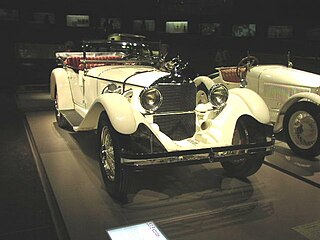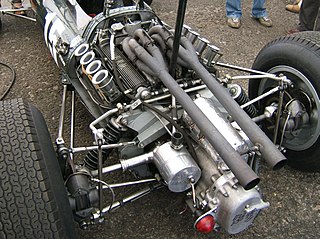Related Research Articles

A V12 engine is a twelve-cylinder piston engine where two banks of six cylinders are arranged in a V configuration around a common crankshaft. V12 engines are more common than V10 engines. However, they are less common than V8 engines.

Vanwall was a motor racing team and racing car constructor that was active in Formula One during the 1950s. Founded by Tony Vandervell, the Vanwall name was derived by combining the name of the team owner with that of his Thinwall bearings produced at the Vandervell Products factory at Acton, London. Originally entering modified Ferraris in non-championship races, Vanwall constructed their first cars to race in the 1954 Formula One season. The team achieved their first race win in the 1957 British Grand Prix, with Stirling Moss and Tony Brooks sharing a VW 5, earning the team the distinction of constructing the first British-built car to win a World Championship race. Vanwall won the inaugural Constructors' Championship in Formula One in 1958, in the process allowing Moss and Brooks to finish second and third in the Drivers' Championship standings, winning three races each. Vandervell's failing health meant 1958 would be the last full season; the squad ran cars in a handful of races in the following years, but finished racing in 1961.

Formula Two is a type of open-wheel formula racing category first codified in 1948. It was replaced in 1985 by Formula 3000, but revived by the FIA from 2009–2012 in the form of the FIA Formula Two Championship. The name returned in 2017 when the former GP2 Series became known as the FIA Formula 2 Championship.
William Simpson Aston was a British racing driver who participated in three World Championship Grands Prix, in 1952 when the championship was run to Formula Two rules, for his own team Aston Butterworth.

Peter Westbury was a British racing driver from England. He participated in two World Championship Formula One Grands Prix, scoring no championship points. In 1969 he raced a Formula 2 Brabham-Cosworth, driving in his first Grand Prix in the 1969 German Grand Prix. He finished ninth on the road, fifth in the F2 class. The following year he failed to qualify for the 1970 United States Grand Prix driving a works BRM, after an engine failure.
The Ferrari P was a series of Italian sports prototype racing cars produced by Ferrari during the 1960s and early 1970s.

The Ferrari250 Testa Rossa, or 250 TR, is a racing sports car built by Ferrari from 1957 to 1961. It was introduced at the end of the 1957 racing season in response to rule changes that enforced a maximum engine displacement of 3 litres for the 24 Hours of Le Mans and World Sports Car Championship races. The 250 TR was closely related to earlier Ferrari sports cars, sharing many key components with other 250 models and the 500 TR.

The Lotus 31 was a racing car produced by Lotus for the new 1-litre Formula 3 introduced in 1964, replacing the expensive Formula Junior. The chassis was a multi-tubular spaceframe, of similar design to the 1962 Lotus 22 Formula Junior. A 997 cc (60.8 cu in) Ford Cosworth 105E with Single Choke Weber or SU carburettors produced 97 bhp (72 kW) at 8000rpm. The 31 had little success against the more advanced monocoque cars that dominated in 1964. Records show only 12 were built in 1964/5.

The Mercedes-Benz W196 was a Formula One racing car produced by Mercedes-Benz for the 1954 and 1955 F1 seasons. Successor to the W194, in the hands of Juan Manuel Fangio and Stirling Moss it won 9 of 12 races entered and captured the only two world championships in which it competed.

The Brabham BT19 is a Formula One racing car designed by Ron Tauranac for the British Brabham team. The BT19 competed in the 1966 and 1967 Formula One World Championships and was used by Australian driver Jack Brabham to win his third World Championship in 1966. The BT19, which Brabham referred to as his "Old Nail", was the first car bearing its driver's name to win a World Championship race.

The FIA Formula Two Championship was a one-make class of auto racing for Formula Two open wheeled single seater racing cars. The championship was contested each year from 2009 to 2012. It was a revival of the former European Formula Two Championship that was previously run from 1967 to 1984. Organised by MotorSport Vision, drivers competed over 16 rounds at eight venues, in identical cars built by Williams Grand Prix Engineering, with 400 bhp engines developed by Mountune Racing and supplied by Audi.

The Cooper Mark IV was a Formula Three, Formula Two and Formula One racing car designed and built by the Cooper Car Company at Surbiton, Surrey, England, in 1950.

Charles Newton "Charlie" Cooper was a British motorsport mechanic, designer and entrepreneur.

A Formula E car is an open-wheel auto racing car made according to the regulations of the International Automobile Federation (FIA) to take part in the FIA Formula E Championship. Formula E is a sport for electric cars, and they are powered by batteries and an electric motor. Races are mainly driven on closed temporary street circuits designed specifically for this racing category.
Don Parker was a British racing driver from England who was British Formula Three Champion on three occasions. He also competed in the British Saloon Car Championship.

The Mercedes-Benz S-Series (W06) was a successful line of sports cars produced from 1927-33 that bore the nickname, the "white elephants."
The Ford Indy V8 engine is a naturally-aspirated, pushrod, V-8, Indy car racing engine, initially specially designed by Ford for use by Team Lotus, to compete in the Indianapolis 500; from 1963 to 1967. This is the engine that gave Jim Clark the victory in 1965 with his Lotus 38 chassis, Graham Hill victory in 1966 with his Lola T90 chassis, and A. J. Foyt the win at Indianapolis in 1967, in his Coyote 67 chassis.

The British Racing Motors V8 was a four-stroke, naturally aspirated, 1.5 L (92 cu in), V-8 racing engine, designed, developed and built by British Racing Motors (BRM) to compete in Formula One racing (although an enlarged 2.0 L version was used for sports car racing. It was built between 1962 and 1967, and came in two version; the P56, and the P60.
The McLaren M3 was an open-wheel race car, designed, developed and built by British manufacturer McLaren in 1965. It was used mostly in Formula Libre racing, but was very versatile and competitive, and was also used in other motorsport categories and disciplines, such as hillclimb racing, and sprint car racing. It used no particular engine, but was capable of using ; an Oldsmobile V8, a Ford FE, a Ford Indy V8, a Repco V8, a Maserati V12, or even a 2.5–2.7 L (150–160 cu in) Coventry Climax four-cylinder Formula One engine. The chassis was constructed out of a tubular space frame, covered in an aluminum panel body, with extra aluminum riveted and bolted to the undercarriage of the car, to add extra strength and rigidity. This meant weight was around (approximately) 1,100 lb (500 kg).
The McLaren M25 was an open-wheel racing car, designed by John Barnard, and developed and built by British constructor McLaren in 1973. It was based on the successful McLaren M23 Formula One car. It was originally built with the intention to be a Formula 5000 car, but it did not compete in any F5000 races, and didn't even contest in a motor race until 1976, which by that, was too late, since Formula 5000 racing had folded. It then became a Formula One car for Emilio de Villota, and was equipped with a 3.0 L (180 cu in) Ford-Cosworth DFV V8 engine, where it only entered one World Championship Grand Prix, the 1978 Spanish Grand Prix. de Villota damaged the car in an accident during the practice session for the race, so the team reverted his car back to the M23.
References
- ↑ Long, Brian (January 15, 2008). Daimler V8 S.P. 250: New Edition. Veloce Publishing Ltd. ISBN 9781904788775. Archived from the original on June 18, 2022. Retrieved June 18, 2022– via Google Books.
- ↑ "Cooper".
- ↑ "The Felday cars". Motor Sport Magazine. Archived from the original on 2021-04-14. Retrieved 2022-06-18.
- ↑ "R.A.C. Hill-Climb Championship—1963". Motor Sport Magazine. Archived from the original on 2022-01-10. Retrieved 2022-06-18.